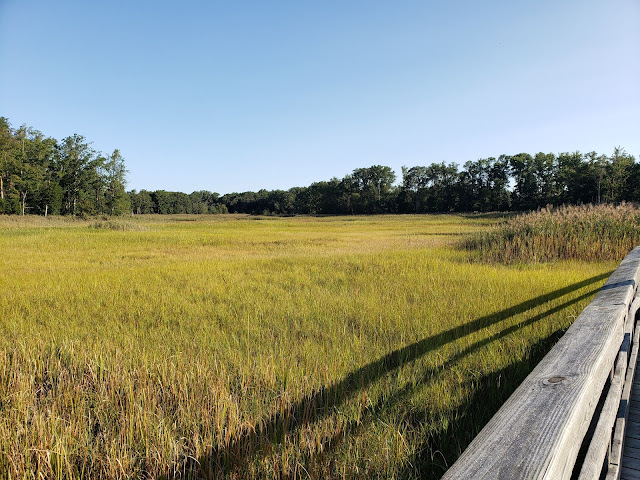St. Jones Reserve and Ted Harvey Wildlife Area: A Stunning Morning Walk
 |
| One of the views along St. Jones Reserve's nature trail |
We spent 2020’s first day of Fall on one of the most beautiful and memorable walks we’ve ever taken, on a nature trail through St. Jones Reserve and Ted Harvey Conservation Area.
St. Jones Reserve is on Kitts Hummock Road, just past John Dickinson Plantation. It’s part of the Delaware National Estuarine Research Reserve, so there’s research going on here as well as environmental protection and education. Estuaries are the intersections of land, fresh water, and salt water. St. Jones Reserve includes fresh water from the St. Jones River and its tributaries, salt marshes fed by the Delaware Bay, and forested and open land.
The nature trail is to the right of the Center for Estuarine Studies, which was closed when we visited because of the pandemic.
 |
| St. Jones Center for Estuarine Studies |
The trail begins just past a native plant garden.
 |
| St. Jones native plant garden |
Part of the trail is a boardwalk over salt marshes. There are some wayfinding signs with information on the marshes.
 |
| Part of the St. Jones nature trail's boardwalk |
There’s a weather station here for research.
 |
| St. Jones Reserve weather station |
We saw hundreds of tiny, busy fiddler crabs under the boardwalk. Notice that they have just one large claw.
 |
| Fiddler crabs in St. Jones Reserve |
Another part of the trail is a forest trail.
 |
| St. Jones Reserve nature trail |
At one point, near where the trail crosses into the Ted Harvey Wildlife Area, the trail was marked closed. We suspect this is because it was the beginning of hunting season, and hunting is allowed in Ted Harvey. Because it was so early in hunting season, we decided to keep going.
 |
| Signs as the trail enters Ted Harvey Wildlife Area |
The trail then skirts some fields.
 |
| Yarrow along the nature trail through Ted Harvey Wildlife Area |
The trail ends at an architectural gem: a house known variously as Kingston-upon-Hull, Town Point, and Logan's Lane. (I like to call it Kingston-upon-Hull because that sounds the most romantic. 😊). It’s surrounded by a fence, presumably to protect it from vandals.
 |
| Kingston-upon-Hull in Ted Harvey Wildlife Area |
The left side of the ground floor in the photo above is the
original section of the house, probably built around 1677. The kitchen wing on
the right was added later. John Dickinson, one of the United States' founding fathers, bought this house and land in 1796
and leased it to tenant farmers, a practice continued by his descendants for
generations. The frame second story was added in the early 1800s. Because it
was occupied by tenants who couldn’t alter it, the house looks much as it did
when John Dickinson owned it.
One of the things that makes the house special is its brickwork. The house has three different brick patterns here—remarkable considering this house was built in the 1600s in a rural area. The bricks in the front of the house, shown below, are a lovely Flemish bond. The line that runs across the doorway and then down is a water table: a line of bricks protruding a bit from the house. The idea was that rain falling on the wall would splash away from the wall, protecting the foundation a bit. The brick below the water table also appears to be Flemish bond but with lower quality bricks.
 |
| Kingston-upon-Hull's Flemish bond brickwork |
The rear of the original section, shown below, is English bond, with alternating rows of bricks laid lengthwise and cross wise. Brick walls are actually two walls of brick, one behind the other. Bricks laid crosswise hold the two walls together.
 |
| Kingston-upon-Hull's English bond brickwork |
The rear of the kitchen wing, shown below, is common or stretcher bond, the kind we typically see in homes built today. In roughly every sixth row, the bricks are laid crosswise rather than end-to-end.
 |
| Kingston-upon-Hull's common bond brickwork |
But back to the trail. We’ve been on stunning walks, including along the Maui shoreline in Hawaii. Why was this one of our all-time favorites? One reason was the luck of taking the walk on a picture-perfect morning with perfect weather. Another is there was no one else on the trail when we visited, making it extraordinarily peaceful. Who wouldn’t walk on a trail like the one below and feel at peace with the world?
 |
| St. Jones Reserve nature trail |
More information on St. Jones Reserve is here and here.
The trail is open dawn to dusk, seven days a week, although I wouldn’t walk the trail during hunting season.
If you don’t want to walk to Kingston-upon-Hull, you can drive to it by going a little farther down Kitts Hummock Road and turning right into Ted Harvey Wildlife Area, also known as Ted Harvey Conservation Area and Ted Harvey Wildlife Management Area. The area is used primarily for hunting and fishing, and I wouldn't visit Kingston-upon-Hull during hunting season.









Comments
Post a Comment